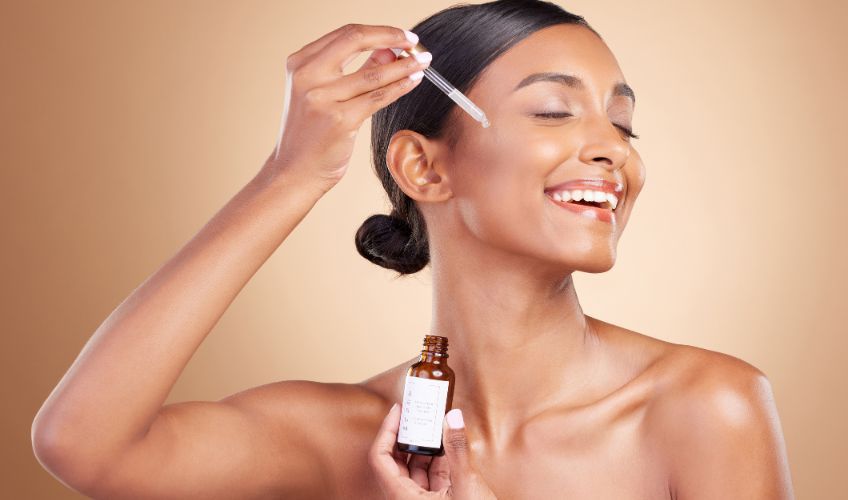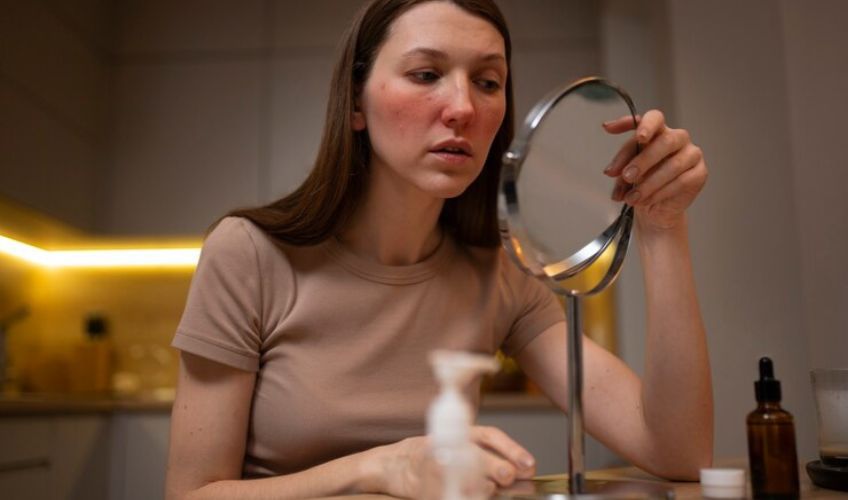Is it okay to use glycolic acid with retinol? This common question causes confusion for many. According to dermatologists, both can be incorporated into a skincare routine, but specific precautions must be taken.
The most important tip is to avoid applying glycolic acid and retinol simultaneously. Initially, use them at different times of the day or on different days of the week. Gradually, you can shorten the interval between their applications.
Understanding the proper way to use glycolic acid with retinol requires knowledge of their mechanisms and the science behind them.
{tocify}
What is Glycolic Acid?
Glycolic acid, derived from sugar cane (1), is an alpha hydroxy acid that chemically exfoliates the skin by breaking down bonds between skin cells, removing dead skin, and evening out skin tone. This results in a refreshed complexion, making glycolic acid a popular ingredient in cleansers, masks, peels, and serums.
Glycolic acid also enhances the effectiveness of other treatment ingredients, such as phytic acid, by improving their ability to penetrate the skin, thereby combating hyperpigmentation and bringing a radiant glow to the face.
Since glycolic acid is a regulated substance, its concentration in over-the-counter products is limited to no more than 30 percent. However, dermatologists may use higher concentrations for professional chemical peels.
When using glycolic acid products, keep the following guidelines in mind:
- A face wash containing glycolic acid can be used once daily.
- An active serum with glycolic acid can be applied once or twice a week, but depending on skin tolerance, it can be used up to three times per week.
- Glycolic acid peels and masks are recommended 2-3 times per week.
What is Retinol?
Retinol, a topical form of vitamin A, helps reduce fine lines, skin discoloration, and clogged pores (2). It promotes collagen production and accelerates cell turnover. Given that it is a milder retinoid compared to others, it is more readily available without a prescription.
Retinol works by boosting collagen and other essential compounds for healthy, glowing skin (3). It treats acne by unclogging pores, improving skin texture and overall appearance.
Retinol is highly effective in combating signs of aging by diminishing wrinkles and fine lines. Nevertheless, excessive use may lead to skin dryness. Therefore, it is recommended to use a suitable amount based on your skin type.
Retinol is available over the counter in forms such as creams or serums. The best method to apply retinol is on cleansed skin once or twice a week at bedtime, followed by a moisturizer. Gradually increase its usage as your skin adapts to it. Since retinol increases sensitivity to UV rays, it is crucial to use sunscreen daily.
How to Use Retinol and Glycolic Acid Together?

Initially, there was a misconception that one must choose between glycolic acid and retinol for their skincare routine. This belief stemmed from the unfounded notion that glycolic acid interferes with retinol’s effectiveness.
Recent research, however, indicates that using glycolic acid alongside retinol is safe if done under proper guidance and instructions (4). In fact, this combination can be more effective in treating acne and reducing acne scars.
Both glycolic acid and retinol can cause skin irritation. Therefore, dermatologists advise using them alternately in your skincare regimen. Some general tips for using glycolic acid and retinol safely to minimize irritation include:
- Create a schedule for using glycolic acid and retinol, ensuring you alternate their application days.
- Begin with glycolic acid once a week to see how your skin reacts, then gradually increase usage to a few times a week or every other day. Allow your skin time to adjust.
- After your skin adapts to glycolic acid, introduce retinol by applying it once a week to monitor its effect.
- Gradually increase retinol usage, alternating with glycolic acid application.
- When your skin is fully accustomed and shows no signs of irritation or dryness, you can try applying one in the morning and the other in the evening.
- Avoid using active ingredients like Vitamin C and Alpha Hydroxy Acid directly after glycolic acid application to prevent severe irritation and dryness.
- Retinol can make your skin more sensitive to sunlight and UV radiation, so always apply sunscreen.
- Consistently use a moisturizer to combat potential dryness caused by glycolic acid and retinol.
- Pregnant and breastfeeding women should avoid retinol and consult a dermatologist before using glycolic acid.
How To Choose Between Glycolic Acid And Retinol
If combining glycolic acid and retinol causes skin problems, choose one based on your skin type and specific needs. Although many can use both simultaneously without issue, some skin types may react adversely.
Identify your primary skincare goal and the immediate concern needing attention, and select the corresponding ingredient accordingly.
Use Retinol If Your Primary Concern Is To Treat Aging Skin
Retinol rejuvenates skin cells by diminishing the appearance of fine lines and wrinkles (5).
While it doesn't remove dead cells, it enhances the health of current cells. Additionally, retinol mitigates the impact of sun damage, providing a more supple complexion. It also clears out pores that may lead to acne, ultimately improving skin health.
Use Glycolic Acid If Your Skin Is Sensitive
Glycolic acid tends to cause less irritation in comparison to retinol since it is not as drying. It acts as an exfoliant, capable of removing dead skin cells and excess oil from blocked pores. Glycolic acid is particularly effective for oily skin that experiences discoloration or texture complications.
Side Effects Of Using Glycolic Acid And Retinol Together
Both glycolic acid and retinol are powerful ingredients that need to be used accurately and with care. Overuse of either glycolic acid or retinol can harm the skin and lead to additional problems.

Although generally safe, some potential side effects include:
- Combining glycolic acid with retinol can heighten sensitivity to sunburn and cause skin damage. Therefore, it is crucial to use these products with sunscreen to prevent the adverse effects of UV rays.
- Occasionally, applying glycolic acid and retinol may result in skin peeling, flaking, and itchiness. These effects are usually temporary, and the skin normalizes as it acclimates to the products.
- In severe cases, there could be redness and swelling of the skin. If this occurs, discontinue use immediately and consult a dermatologist.
- Individuals with darker skin tones might experience hyperpigmentation due to the use of glycolic acid and retinol.
Conclusion
Choosing between glycolic acid and retinol or deciding to use them together can be challenging. However, identifying your skin type will help you select the appropriate product. Begin with a lower dose initially and consult a dermatologist when necessary.
You Might Also Like:
How Long Does Botox Take To Work?
Is Botox Effective for Reducing a Double Chin?
